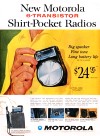Hugo Gernsback Editorial: Transistor Transition |
|
Editorial: Transistor Transition The transistor will soon be ready to transform the industry...
The evolutionary path of radio science is dotted with a number of milestones. Earliest known to most of us is the spark-gap transmitter and coherer of the "wireless" days, with which the first commercial signals were sent and received. The coherer was soon replaced by the crystal detector and other rectifying devices, while the spark transmitter was partly supplanted by the arc and alternator. When the vacuum tube made its triumphant and revolutionary entrance into the field - expanding radio to a degree that even its boldest protagonists had never envisioned - all these earlier devices were doomed. First in receivers, and a little later in transmitters, the vacuum tube became supreme, and from a little after 1907 till the present, has dominated the industry. Even when television burst upon the scene - bringing still another new era with it - the vacuum tube still remained as the most important component of television transmitters and receivers, second only to the cathode-ray picture tube (itself a vacuum tube of special type). With the recent advent of the transistor, the vacuum tubes will in the foreseeable future be in eclipse, although they will always be with us. Transistors will never completely supplant the ubiquitous electron tube. The time will soon arrive when the transistor will begin to revolutionize the radio-electronic industry. This will be sooner than was expected, even by its inventors. Shortly after the advent of the transistor, handmade specimens sold around $18.00 apiece. Very recently the price was around $8.00. This, naturally, is but a beginning. It is certain that transistors, when finally mass-produced, will sell at a lower price than present-day vacuum tubes. For this reason, all of us in the industry should ponder how the transistor will affect and indeed revolutionize most branches of radio-electronics. No one doubts today that radio and television receivers will in the future be transistor-equipped; indeed, the trend is certain to be irresistible for many reasons. Not requiring any heating elements, there will be a large saving in electric current. The size of radio and television sets will shrink considerably. So will their weight, and, most important of all, much less labor will be required in manufacturing receivers. Thus they can be sold at a lower price than at the present time. Transistors should last for a long time because there is nothing to wear out and there probably will be fewer replacements. Radio as well as television sets will not heat up anywhere as much as our present-day ones. Consequently, such parts as resistors and capacitors will not be so apt to become defective on account of heat effects. In addition to using transistors, appliqued circuits - the so-called printed circuits - are also certain to be used in the near future, making for still greater price reductions of such receivers. So much for the present-day type of set. However, we will have many other more important new devices in the future. I refer to the miniradios, which could not be manufactured economically with vacuum tubes. Now with transistors, drawing minute current from low-voltage batteries, radios the size of a match box and smaller, are certain to be made in the future. The public has always shown a great deal of interest in personal pocket or handbag radios. Mass-produced, they can be sold at a very reasonable price and will fulfill a distinct need. As our civilization becomes more complex, people, no matter where they are, want to obtain instant news, time and weather reports, as well as other special services. These, the stations of the future will provide. Such small pocket radios need merely be held up to the ear to receive local radio stations instantly. Other miniradios, the size of fountain pens, already predicted by the writer in the April, 1946 issue of this magazine, will become commonplace. The same is true of watch-size and wristwatch radios, as well as other miniature types of personal receivers. Millions will be sold. The transistor television receiver is no longer a future prediction. Very recently the Radio Corporation of America engineered a portable television receiver which was shown to the press last November. Admittedly a laboratory stunt - to demonstrate what could be accomplished with transistors - this receiver had no vacuum tubes, but it did have the usual type of cathode-ray television picture tube. This brings up the question: Will it ever be possible to have a sort of transistor picture tube? We believe this belongs distinctly in the realm of future possibilities. If this is doubted, all one has to do is study the human eye, which, like the transistor, works on a minimal amount of electric current. The processes of seeing, as scientists maintain, is electro-chemical. It would seem quite possible that in the future some such a device may be produced. Its dimensions will probably be much smaller than the present type of cathode ray tube. It may not be larger in any dimension than 2 inches. This means that it will have to be a projection-type device, throwing the image or picture onto a small portable screen that can be rolled up or folded when one desires to view a program. Where does the service technician fit into this complex future industry? To begin with, all technical progress is gradual. Millions of present-day radio and television sets will still have to be serviced for several decades to come. Future transistor sets will not require anywhere near as much servicing as do present-day receivers. On the other hand, it is certain that there will be between three to five times as many radios and televisors as we have now. Consequently, even if the percentage of breakdown is less, the service technicians will still have their hands full trying to give adequate service in the future. As a matter of fact, there will have to be many more thousands of service technicians twenty years hence than we have at present, if they are to keep up with the work. The service technician also will have to change his thinking and his techniques when it comes to servicing transistor receivers. He will have to completely re-educate himself to the new trend, just as he had to reorient himself when television arrived on the scene. In this he will be benefited enormously. All in all, the service technician of the future will be a far better and more precise individual than he ever was before and we are certain his earning powers will be greatly enhanced too.
Posted August 14, 2018 |
|

 Hugo Gernsback was well-known
not just for his technical prowess, but for an uncanny ability to predict future developments
in electronics, transportation, and production methods. Barely three years had passed
since Messrs. Bardeen, Shockley, and Brattain, announced their invention of the transistor
when this editorial titled, "Transistor Transition" appeared in Radio-Electronics
magazine. Gernsback mentions the concept of "appliqued circuits" (i.e., printed circuits)
and "roll-up display" transistor picture tubes (i.e., flexible displays), and "pocket
radios" that can be held up to the ear. Production
prices for transistors at the time were about $8 apiece, which is the
Hugo Gernsback was well-known
not just for his technical prowess, but for an uncanny ability to predict future developments
in electronics, transportation, and production methods. Barely three years had passed
since Messrs. Bardeen, Shockley, and Brattain, announced their invention of the transistor
when this editorial titled, "Transistor Transition" appeared in Radio-Electronics
magazine. Gernsback mentions the concept of "appliqued circuits" (i.e., printed circuits)
and "roll-up display" transistor picture tubes (i.e., flexible displays), and "pocket
radios" that can be held up to the ear. Production
prices for transistors at the time were about $8 apiece, which is the
 By Hugo Gernsback
By Hugo Gernsback